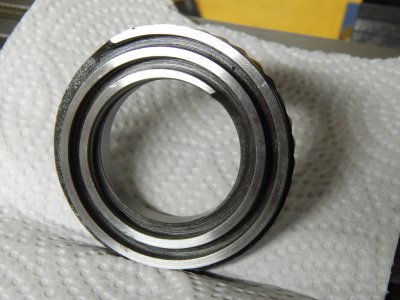Now, as some on here will remember, during a bearing change to angular contact bearings, I managed to make a series of daft mistakes with a hydraulic press and (amongst other things) broke the front-most as-supplied ball bearing, leaving the cage firmly stuck on the spindle near the spindle flange.
I tried everything I could think if and the damn thing wouldn't come off, so I ended up using a bench grinder to grind away at the stuck cage until the cage split on it's own and was able to be removed. It must have been under a lot of expansive pressure to split even that relatively thin remaining material after the grinding (I suspect I had pushed the bearing onto an inaccurately machined part, an enlarged fillet if you will, at the shoulder of the head of the spindle).
Anyhow, during my somewhat clumsy grinding, I had nicked part of the spindle head (the thicker shoulder that should butt up against the front most bearing) a bit [ahem] and had removed, probably about 10% of the mass of that bit of the head.
Before I had attempted the bearing change, I noticed at around 1230 RPM, the lathe would vibrate a bit, and then quieten down somewhere around 1280 RPM.
So I had this almost certainly unbalanced spindle and nothing else (the spindle I had on my 7x14 was just different enough from the C3 and SC3 to have to go through the original importer and they said 6-8 weeks for a replacement) so I thought "What's the worst that can happen?" and (a lot more carefully this time) put the new bearings on this rather abused spindle.
Now unexpectedly, I seem to have no
worse problems with vibration than I had before. It's now just moved to a range of 1520ish - 1565ish RPM; a slightly smaller range...eh...

So to sum up. It may be a bearing change will fix it for you but with my experience, I suspect it's something you'll have trouble fixing. It hasn't got in my way so far and at some point I'll get a Boxford or an ML7 and it will cease to be a problem.



